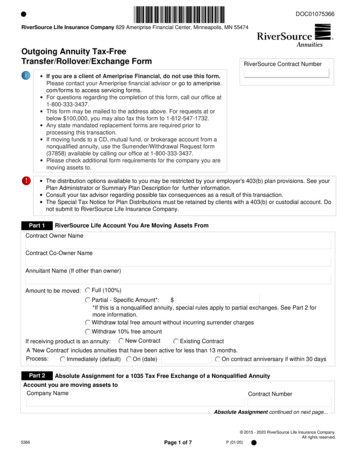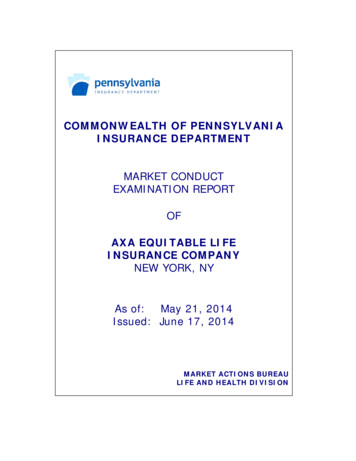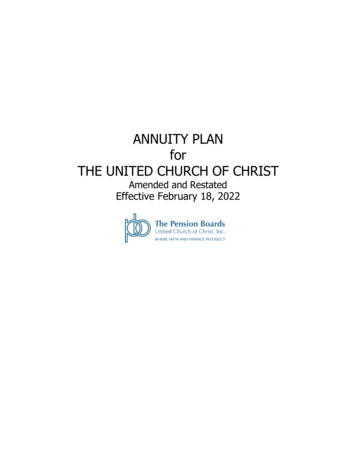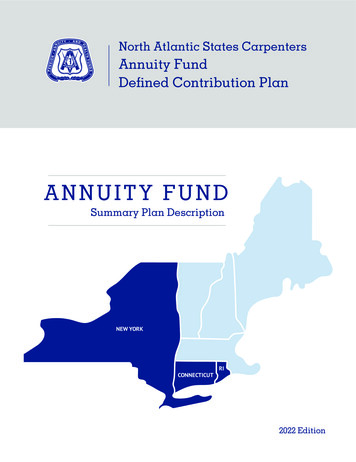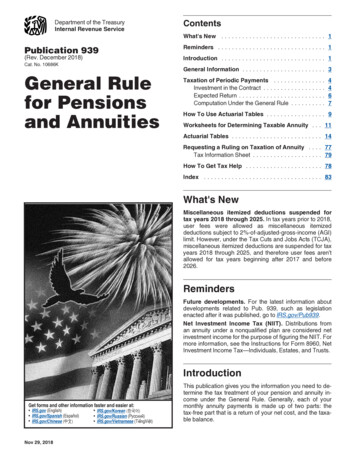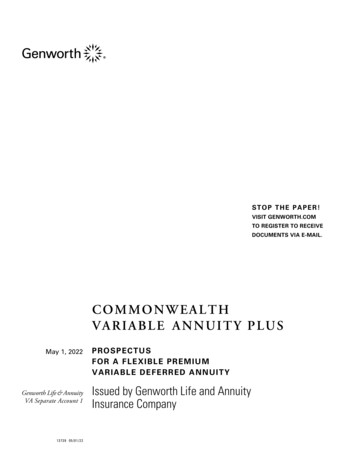
Transcription
The future of annuity administrationsystems in the UKNovember 2011Pete Ryan, SapiensFor more information please contact us at info@sapiens.com
The future of annuity administration systems in the UKTable of contentThe future of annuity administration systems in the UK .2Traditional annuity systems .2Changes to annuities in over the last decade .3The future of annuities.4Annuity administration systems for the future .61www.sapiens.com
The future of annuity administration systems in the UKThe future of annuity administration systems in the UKThe annuity product sold both as a retirement vehicle and as a pure income product hashistorically been one of the most stable product types sold in the UK life and pensionsmarket. This has been reflected in the nature and level of administration systemssupport provided to the market in the UK. Annuity administration support has traditionallyfollowed one of two standard templates: either additional functionality built into a coverall life and pensions administration system; or small, in-house systems, built as anadjunct to an off-the-shelf payroll system.However, the last ten years has seen increasing pressure in the way annuities are soldand administered in the UK. The introduction of asset-backed annuities and third wayannuities has increased the breadth of choice available to annuity purchasers. Increasedlegislation (the pensions act of 2004, Solvency II, RDR) have added pressures to theway annuities are administered. And a future in which the underwriting and pricing ofannuities is expected to become more individual points towards even more change.From an annuity provider’s perspective, it is clear that the existing approach toadministration systems provision is no longer appropriate or capable. This paper looks atthe nature of the pressures on the annuity market and how modern annuityadministration systems need to adapt to react to those pressures.Traditional annuity systemsHistorically system support for annuity administration in the UK has followed one of twotemplates: annuity functionality built into one standard life and pensions administrationsystem, or smaller in-house models allied to payroll software.The first model is a legacy of the extensive import of North American basedadministration systems in the 80s and 90s (e.g. CAPSIL, Life70), where the annuityproduct is simply considered another life product and, in the case of retirement annuities,the accumulation and payment phases are different elements of a single product. In aclear case of existing systems directing design for future business solutions, subsequentUK based systems incorporated this approach (e.g. Unisure, Lamda).There are advantages to this model. For one, the basic new business set-up andsubsequent payment administration of traditional annuity products can easily re-usethose processes and functions already in place for non-annuity life and pension2www.sapiens.com
The future of annuity administration systems in the UKproducts. In addition, product features such as guarantees and indexation can beadapted from similar features in the non-annuity world.The biggest variation from the standard L&P income payment product structure in thetraditional model is the regular payment and calculation of tax. The need to trackdifferent PAYE tax codes, to manage different tax regimes and to produce standardisedHMRC returns are all unique features of annuity products.Most L&P administration systems have dealt with this issue through the use of interfacesinto standard payroll systems, rather than attempt to build the complex payrollfunctionality into the administration system itself.This leads us onto the second model, the in-house system allied to an off-the-shelfpayroll model. This takes the basic premise that annuities are essentially simple singlepremium income paying products and, if a separate payroll system is required, it ischeaper and quicker to build independent in-house systems rather than extend the mainL&P administration system. This model has been used extensively throughout the UK.Both of these models worked well within the assumptions of the traditional annuity world,where the annuity product is simply priced, has little post day one administration, issubject to standardised tax regimes and is sold through limited distribution channels.Changes to annuities in over the last decadeThe assumptions of the traditional annuity world were significantly challenged during thelast decade.Starting with the 2004 pensions Act, a number of changes were made to retirementlegislation that expanded the complexity of the annuity market. A-Day introduced arange of new annuity options for retirees including short-term annuities, value protectedannuities and flexible annuities. In addition, the tracking of Personal Lifetime Allowances,the increased flexibility in retirement ages and a re-definition of the role of a dependentwere introduced, all increasing the level of information required by any annuityadministration system. Beyond A-Day, the market has seen a further expansion of thechoice of annuity available to the would-be purchaser, from asset backed annuitiesthrough to the recent third way annuities. Annuity systems are now expected to supporta much wider range of product and product options than ten years earlier.A wider product choice allied to an increasing awareness of the open market option hasmeant an expansion in the role of the advisor. Despite being available since 1978,3www.sapiens.com
The future of annuity administration systems in the UKnotification of OMO rights to retirees was only made compulsory in 2002. This has led toadvisors requesting increased and more detailed information from the insurer, and thusthe administration system. Illustrations and quotations are now expected in real timethrough insurers own websites or portals. Annuity administration systems must now beable to integrate with a number of distribution channels and sales functions.The last decade has also seen a series of consolidations of long term insurers in the UKmarket. From 297 FSA equivalent approved long-term insurers in 2004, there are now129 FSA approved long-term insurers (source: ABI Key Facts). This consolidation trendhas resulted in many insurers operating several distinct books of business, throwing upthe twin issues of maintaining a single point of contact with a multiple policy owningclient and the necessity to provide multi-company accounts separation.One thing that has become evident over the last decade is that the traditional systemsmodel for administering annuities is under increasing pressure. Wider choice, larger datarequirements and an increased need for integration into a wider IT infrastructure are allchallenging the current model.The future of annuitiesOver the next five years, the annuities world will be impacted heavily in five major areas: Increase in size of the annuity market Pricing of annuities Distribution of annuities Governance and taxation An increased demand for annuity flexibilityThe most obvious change is the increase in the size of annuity market. The annuitymarket has tripled in size over the last 15 years in the UK (ABI Research Paper: PensionAnnuities) and there are several reasons for expecting this growth to be maintained intothe near future: The population expansion of the 1950s is now attaining retirementage Defined benefit schemes are rapidly being replaced by definedcontribution schemes4www.sapiens.com
The future of annuity administration systems in the UK Auto-enrolment should increase the number of individuals contributingto pension schemes in near future (currently this figure is below 50%,so there is plenty of scope for increase)In terms of administration systems support, this rapid growth in annuity provision meansthat the older, in-house systems will, for the most part, be incapable of the necessaryscaling required. Future annuity systems must be able to administer larger volumes ofbusiness without any noticeable reduction in performance or accuracy.The second major impact on the future of annuities will be in the area of pricing.Solvency II will have an immediate and direct impact. From 2012 life companies will nolonger be able to use corporate bonds to value their annuity liabilities, but will be obligedto use government gilt rates. The amount payable under a guaranteed annuity willinevitably fall as a result of this. In addition to the Solvency II impact, the recent ECJgender equality ruling will remove the traditional gender differentials in annuity pricing.These changes, allied with continuing uncertainty around the rise of life expectancy inthe UK, mean that the traditional mechanisms used to price annuities are no longervalid. It is almost certain that the industry will move towards the kind of ‘post-code’pricing approach beginning to be used in the General Insurance sector. Ultimately, theindustry is moving towards fully underwritten and individually priced annuities, where theprice is based on a number of lifestyle and genetic factors. This move towardsindividualised pricing is evident in the booming demand for impaired or enhancedannuities.In terms of systems administration, this move towards individual pricing changes the wayin which annuities will be quoted and written. Systems will no longer be able to rely ontable based annuity rates, but will need to be able to access flexible rating engines, inmuch the same way that general insurance models currently work.The distribution of annuities has changed considerably over the last ten years already,but the advent of the Retail Distribution Review may well bring about further changes.Annuities lend themselves to an advice based model, given that the purchase of theannuity is a single transaction. The issue of indemnified payment of commissions is notreally relevant to annuities.Any future annuity administration system must be able to support advice basedremuneration, or at the least, be capable of integrating with future advisor compensationsystems.The governance and taxation of annuities are subject to some major changes over thenext five years. Solvency II not only has a major impact on the pricing of annuities, but5www.sapiens.com
The future of annuity administration systems in the UKwill precipitate an increase in the depth, detail and transparency of the governance ofannuity books. Any annuity system must be able to provide atomic detail of annuitypricing, premiums and payments for use in post Solvency II valuation models.The Real Time Information (RTI) legislation will change the way in tax returns aregenerated for annuities. New interfaces via BACS through to the government gatewaywill be required, and there will be an increase in the flexibility required for generatingthese returns. Any annuity system must have both the capability to integrate with theprescribed interfaces and the flexibility to report according to the individual scheme’srules.Finally, beyond the four points mentioned above, it is not a stretch of the imagination tosee annuity administration following the wealth management model into selfadministered functionality, whereby clients have instant access to their annuityinformation via a web portal. In the case of asset backed annuities it is likely that clientswill want to manage their annuity investment on a day to day basis, selecting from thevast range of funds currently available on wealth management fund supermarketplatforms.One result of people living longer is that retirement is no longer a simple, predictableevent. People will have different needs from their annuities at different age. An active 65year old has different annuity needs to a care supported 85 year old. As such anyannuity system of the future must able to support flexibility in the definition of annuity; itmust able to schedule different payment levels for different ages with different optionsbecoming effective at different ages.Annuity administration systems for the futureSo where does all the above leave the annuity administration system? It is clear that thevolume and rate of change of the annuity business models has far exceeded thecomparative change in the support annuity administration systems. And it is just as clearthat this discrepancy will continue to grow if the current models for annuity administrationsystems continue to be used.A new approach in systems support being required to keep track with the burgeoningannuity world. This model must embrace many of the functions already prevalent in thegeneral insurance world but without compromising the very nature of the annuity productas a long term insurance product. It must be able to provide the security and stability ofthe existing life and pensions systems, with an increased focus on the traceability of6www.sapiens.com
The future of annuity administration systems in the UKdata. But at the same time, it must be able to provide the agility and flexibility needed toprovide rapidly changing annuity products that may well be priced and designed on anindividual basis.In summary, the annuity administration system of the future must have the followingfeatures: A component based architecture – it must be easy to integrate theannuity administration engine with the range of external and internalinterfaces and components that will be relevant in the future. The newmodel must be able to integrate with HMRC interfaces, client andbroker portals in addition to internal systems such as enterpriseGeneral Ledger, Client Relationship Management systems andCalculations Engines One of the components of the new model should be an agile pricingcapability that enables individual pricing – most likely integrating witha dedicated rating engine In addition to the rating engine, the system must either contain, orinterface to, an agile calculations module that is able to react to andreflect flexible charging approaches It must have the capability to either offer, or interface to, a wide rangeof asset classes (such as cash based, equity based, guarantees etc)in order to support new world asset backed annuities Scalability – any future model must be capable of scaling considerablyto support the anticipated increased in the annuity market goingforward.Well defined data models – it must be possible to identify data at atomic levels for use inSolvency II actuarial models.7www.sapiens.com
The future of annuity administration systems in the UKThis document and any and all content or material contained herein, including text, graphics, images and logos, are either exclusivelyowned by Sapiens International Corporation N.V and its affiliates ("Sapiens") or are subject to rights of use granted to Sapiens, areprotected by national and/or international copyright laws and may be used by the recipient solely for its own internal review. Any otheruse, including the reproduction, incorporation, modification, distribution, transmission, republication, creation of a derivative work ordisplay of this document and/or the content or material contained herein, is strictly prohibited without the express prior writtenauthorization of Sapiens.The information, content or material herein is provided "AS IS", is designated confidential and is subject to all restrictions in any lawregarding such matters and the relevant confidentiality and non-disclosure clauses or agreements issued prior to and/or after thedisclosure. All the information in this document is to be safeguarded and all steps must be taken to prevent it from being disclosed to anyperson or entity other than the direct entity that received it directly from Sapiens.USA395 West Passaic StreetRochelle Park, NJ 07662Tel: 1 201-820-3500Canada10 Kingsbridge GardenMississauga, ON, L5R 3K6Tel: 1 905 507 9700United KingdomPierhead St., Cardiff BayCardiff CF10 4DQTel: 44 29 2044 8600/1France27, Avenue de l'Opera75001, ParisTel: 33 1 70 38 53 21IsraelRabin Science ParkRehovot, 76326Tel: 972 8 938 2777The information, content or material herein is provided "AS IS", is designated confidential and is subject to all restrictions in any law regardingsuch matters and the relevant confidentiality and non-disclosure clauses or agreements issued prior to and/or after the disclosure. All theinformation in this document Australiais to be safeguarded and all stepsmust betaken to prevent it Belgiumfrom being disclosed to any person or entity otherUSAUnitedKingdomJapanthan the direct entity that received it directly from Sapiens.4000 CentreGreen Way1 George Street,Schalienhoevedreef 20 Queen’s tower C 11F111 Elizabeth StreetCary, NC 27513Uxbridge, UB8 1QQB-2800 MechelenSydney, NSW 20002-3-5 Minatomirai, Nishi-kuTel: 1 919 405 1500Tel: 44 1895 464 000Tel: 32 15 798800Tel: 61 2 8222 3100Yokohama 220-6211Tel: 81458247778www.sapiens.com
The future of annuity administration systems in the UK 6 www.sapiens.com will precipitate an increase in the depth, detail and transparency of the governance of annuity books. Any annuity system must be able to provide atomic detail of annuity pricing, premiums and payments for use in post Solvency II valuation models.


